
Housing State Policy in Ukraine
In the last few decades Ukraine has undergone deep political, economic and social changes. Its population shrank from 52 mln in the early 1990s to an estimated 42 mln in 2020. The number of households is close to 15 mln and 70% of them are living in cities: 40% in big and 30% in small cities. Around 10% of the country’s population live in its capital — Kyiv. The data on population, households and migration is estimated by the State Statistical Service of Ukraine as the last census was conducted back in 2001.
The housing stock and the number of apartments grew significantly in the last 30 years. The number of housing units in 2018 was more than 17 mln. Even considering the differences in the spatial distribution of housing and population, the lack of knowledge about the internal and external migration and the potential impact of people living with extended family this still shows a mismatch between the number of households and homes. Despite the clear evidence of the shrinking population the authorities and the construction industry are continuing to push for ‘we need to build more houses’ and do not have any clear understanding of how the housing policy works, who are the main beneficiaries of the current conditions, who are the vulnerable groups and how to ensure that they have roofs over their heads.
There was not only a numerical change in the housing sphere, but also a deep structural change in the tenure structure. Ukraine has experienced a rapid growth in the share of homeownership since its independence as a result of mass giveaway privatization. It has one of the highest rates of owner-occupation (over 90%) which has a profound impact on the balance between tenures, the right to the housing, labour markets and patterns of inequality.
The following analysis is dedicated to the problem of guaranteeing the right to housing and to the issues of reforming the state housing policy in Ukraine. This brief presents results of the project of the comprehensive analysis of the current state of the housing policy in Ukraine. It highlights the main findings, future avenues of inquiry and potential recommendations for the reform.
The study was conducted in 2019 by the CEDOS think tank. We analyzed a number of studies about housing policies in different countries; changes in Ukrainian legislation on housing initiated since the country got its independence; available data about the performance of the existing state housing programs as well as the relevant data from the State Statistical Service. Besides that, specifically for the purposes of the study we have conducted a sociological survey. Participants in this survey were representative of the adult population living in the cities of 100 000 or more inhabitants.
Housing is a basic human need. Societies declare “the right to housing” and guarantee access to it through the instruments of housing policy. The cause of difficulties with ensuring the right to housing is a conflict between housing as a roof over one’s head (its use value) and as an asset (its exchange value).
The field of housing is political: in it, different interest groups defend their own vision of what “housing” is, what “housing problems” are and how they should be solved. Housing determines people’s chances in life and their access to other spheres: education, jobs, leisure, etc. The balance between housing tenures determines the possible level of general welfare and shapes the interest groups in society. Comparative housing research aims to understand its place in the wider economic, social, political spheres of various countries, as well as housing policy instruments and their results.
According to its Constitution, Ukraine is a social state. The right to housing is recorded in Article 47 of the Constitution: “Everyone has the right to housing. The state creates conditions under which every citizen will be able to build housing, purchase it to have ownership, or rent it.” Why is it so hard to fulfill this right then? Why does the next part of this Article — “citizens who need social protection are provided with housing by the state and local self-government bodies free of charge or for an affordable fee according to the law” — seem even less realistic?
The mass free-of-charge privatization of housing in Ukraine allowed to absorb the shock of market transformations to a certain extent, but at the same time it shrunk the publicly owned housing stock and entrenched the inequalities that existed at the moment of privatization. The ownership-oriented housing policy in Ukraine manifests itself both in tax and economic preferences and in the lack of incentives to develop the rental sector which could satisfy the population’s need for housing.
If we used the arguments about a “compromise” between social welfare and housing ownership, young Ukrainians would probably be unable to pay high taxes, because in the early stages of their lives they would focus on saving up to make the first installment or spend commensurate amounts to rent housing in the private sector.
As indicated above, housing privatization transformed a place of residence into an often the most expensive asset owned by a household. It would be entirely logical to assume that for some residents, this expensive asset becomes the means to fund their old age at the later stages of their lives. However, the homeownership incentives such as an extremely liberal taxation of real estate allow some households to maintain their wealth by turning into rentiers.
The neverending quest of the development of legislatory base Ukraine has a lot of various legislative acts that regulate the functioning of the housing sphere. Some of them contradict one another, and therefore require regulation. Contrary to the popular idea that the legislation needs to be modernized, Ukraine adopted a regulatory foundation which allowed a real estate bubble to emerge and burst within a few years.
The main document that regulates the housing system in Ukraine is the Housing Code, which came into force after the Verkhovna Rada of the Ukrainian Soviet Socialist Republic issued its Decree of June 30, 1983. The first section of the third chapter in the Code regulates the provision of residential premises for citizens by providing these premises in the buildings of the state-owned and public housing stock. In particular, Article 34 defines the so-called “apartment queue”: citizens that require improvement of their residential conditions apply and register for receiving premises in buildings of the state-owned and public housing stocks and are put on the Unified State Register of Citizens Who Need to Improve Their Residential Conditions.
When the USSR collapsed, Ukraine inherited both the Soviet Housing Code and the “apartment queue” for improving residential conditions. In the period of independence, the queue has become shorter, but the actual cause of the shortening of the apartment queue was the liquidation of the queues in companies due to structural reorganization of companies, mass layoffs, and lack of funding to construct housing. Since 2014 this queue is not centrally administered by the state and although the local municipalities are still collecting data, there is no understanding about the actual housing need in Ukraine.
The two main shortcomings of this Article are its discrepancies with the privatization legislation and its lack of targeted housing aid. Apartments provided according to the Article can de facto be privatized right away, and so the housing stock is transferred from state or public ownership to private ownership. The queue was also based on the so-called “residential norms” (of the area of the housing units), rather than on the financial resources or income levels of the citizens or households.
When the USSR collapsed and Ukraine gained independence, private ownership (including housing ownership) was declared as the foundation for building the market economy. In June 1992, the Law of Ukraine “On the privatization of the state housing stock” was adopted, establishing that privatization should be conducted through transferring housing units to citizens (renters) ownership free of charge.
Privatization was the first step towards the commodification of housing and the further creation of the real estate market. The early 1990s legislation attempted to stimulate construction, because state-budget-funded construction was reducing, and the “apartment queue” was long — new ways of involving non-budget sources of funding needed to be found.
In 1995, the Concept of State Housing Policy was approved; it involved the creation of conditions for the development of stock exchanges, investment funds, mortgage and housing banks, insurance companies and other market structures to provide for housing construction.
Clearly, the mortgage loan market could not be created and could not function without other legislation, not directly related to mortgage lending but forming the environment for its development. In 2001, the Land Code was adopted, while the Civil and Economic Codes were adopted in early 2003.
The financialization of housing in Ukraine
In 1996, the government took a step towards macroeconomic stability, when the national currency — the hryvnia — was introduced, allowing to regain control over inflation. In late 1999, the country was on the brink of default due to the lack of faith in its capacity to service its debt, which pushed the political elites towards implementing reforms. As a result, the 2000–2003 period brought economic restoration combined with wage growth. Until 2004, Ukraine’s growth rate was high, inflation was low, and the budget was balanced.
When the new currency was introduced and hyperinflation was overcome, the National Bank of Ukraine unofficially linked the national currency to the American dollar (5.44 UAH to 1 USD) in the late 1990s. This allowed the currency risks to be placed on the borrowers and had consequences during the crisis and the devaluation of the hryvnia in 2008.
Until 2002, the main role in the process of funding the construction and purchase of housing was played by non-banking sources: fewer than 10 banks worked in the mortgage lending market. The first installment was between 30% and 50%, the maximum loan period was 5 years with 14% interest and above for the loans linked to other currencies and 20% interest and above for loans in hryvnias. The banks had problems both with liquidity, because they didn’t have internal long-term resources, and with evaluating the risks of lending, especially in the circumstances when a significant portion of the population had some undeclared income.
The experience of losing savings deposits when the USSR collapsed and the experience of hyperinflation undermined people’s trust in the banking system. Banks needed liquidity to provide loans, and they found it in major European banks; when the latter bought local banks, they gained a potentially big market. Thus, non-Ukrainian banks owned over 50% of all bank assets in the crisis period. The mortgage lending market did not just expand, it also consolidated: the market share of mortgages from the largest 10 banks was 87% in 2007. Under the conditions of a stable currency exchange rate, borrowers took loans in foreign currencies, and the high rates of inflation actually allowed them to “reduce” their payments. When the hryvnia was devalued (“dollar for 8”), the borrowers faced problems. In June 2009, the Law of Ukraine “On introducing changes to some laws of Ukraine to overcome the negative consequences of the financial crisis” (#1533-VI of June 23, 2009) was adopted; among other things, it imposed a moratorium on evicting people who took mortgages to buy housing. On the one hand, this allowed the borrowers to keep their homes and avoid social tensions; on the other hand, it later led to a growth of the proportion of problematic loans in the banks’ portfolios. The global economic crisis dealt a blow to housing construction, labor markets, and the Ukrainian economy in general.
The Ukrainian real estate market has completed almost the whole process of mortgage lending development before the crisis (it was not characterized by securitization because the banks had other sources of liquidity).
Which options for realizing their right to housing were proposed by the government to those citizens who could not or did not want to purchase housing or take mortgage loans? In 2005, the Cabinet of Ministers approved the Concept of the Government Social Housing Program (Decree #384-r of September 3, 2005). In the period between 2006 and 2015, it was planned to provide the people who were on the apartment register list as of January 1, 2005, with social housing. This was an attempt to transform the “apartment queue” into the list of those who needed social housing; this housing would not be eligible for privatization, reservation, buyout or mortgaging. In half a year, in January 2006, the Parliament passed the Law of Ukraine “On the housing stock of social purpose” (#3334-IV of January 12, 2006). Article 10 of the Law defines the grounds of eligibility for being registered on the social housing list and indicates that being on the social housing list is not a reason to deny registration in the apartment register. De facto, the state undertook to provide housing twice: first through the social housing list, and then once again through the list for improving residential conditions.
In the following years in addition to the so-called “apartment queue,” Ukraine has adopted dozens of various branched housing provision programs, but all of them are aimed at expanding homeownership. Social housing stocks and temporary use housing stocks have never been created. The public rental sector hardly even exists since the privatization, and the private rental sector is almost completely unregulated and provides no protection to either tenants or landlords. Instead of numerous state housing programs which are not coordinated at all, Ukraine requires a comprehensive and all-encompassing state housing policy which would clearly explain how exactly the state is going to create conditions for realizing the right to housing.
The available data and its shortcomings
The lack of clear goals of public housing policy means that collection and analysis of housing data is practically non-existent either. This, in turn, creates difficulties with analyzing and evaluating the effectiveness of the existing policies and developing potential recommendations.
The existing statistics on the housing stock, housing construction, and the population’s residential conditions does not allow us to understand either the population’s housing needs or the changes in the housing supply. Today, Ukraine does not have a unified register of persons who need their residential conditions to be improved. The last assessment of state housing programs was conducted back in 2012 and showed that the programs were economically ineffective and socially unfair.
The state statistics
We decided to find out what kind of data on the housing sphere is collected and produced by the State Statistics Service of Ukraine (hereafter referred to as “the Statistics Service”). First of all, these are the data cited in their speeches by everyone who is involved in the housing sphere in one way or another. These are “the most official” data which the government has about the housing sphere. They are the basis on which policies are supposed to be developed, implemented and evaluated.
In 1991, the total area of the housing stock in Ukraine was 923 million square meters. Of these, 63% (577,000 m2) were located in urban settlements, and this portion has not shrunk over the whole period of Ukraine’s independence. Although in the 1990s, the rates of construction generally fell, the total area still grew to over 1 billion m2 in 1997 and to 1,1 billion m2 in 2013; the total area of the housing stock in urban settlements exceeded 700 million m2.
The total amount of residential area is not the only thing that is important for housing policies; it is also important to know how it is “divided”: how many potential homes for households exist. In 1995, Ukraine had 18.3 million apartments (including 64% — 11.7 million — in urban settlements); by 2013, the number increased by a million.
The absolute rates of commissioning of housing units reduced by almost three times between 1991 and 2000 — from 14.4 to 5.6 million m2 (from 11 to 4 million in urban settlements); in the period before the global economic crisis, the commissioning rates doubled to 10.2 million m2 (7.7 million in urban settlements) and remained at approximately the same level after 2010. In fact, in the past decade, the total area of the housing stock in Ukraine grew by about 1% annually. However, it is important to understand where exactly this growth happened: while in the majority of regions, commissioning of housing units fell in the 1990s, Kyiv started to grow already in 1995; and since the early 2000s, the Kyiv Region has been growing as well.
The data on the distribution of commissioned buildings by types show that the fraction of apartment houses is growing. While in 2003, the rate of single-household buildings to apartment buildings was 3:2, in 2017, the situation was directly opposite. In addition, we can see that the fraction of dormitories does not even reach 0.5%, which shows that individuals no longer have any alternative to ownership or renting. In the period since 2005, almost 100 dormitories with a total area of 420,000 m2 have been commissioned in Ukraine.
In addition to the fact that new dormitories are not being constructed, the total residential area in dormitories has been falling in all Ukrainian regions. From about 30 million m2 in 1991, it has reduced by a third, to less than 20 million m2.
As of 2018, the overwhelming majority of households in Ukraine (94%) live in separate apartments (47%, mostly in cities) or individual houses (48%, mostly in rural areas); in the whole period of 1999–2018, these rates have kept up without any significant change.
According to the Statistics Service data, in the period of 1999–2018, a very small fraction of the population — only 1–4% — live in housing units rented from private individuals. However, given the scale of the shadow rental market in Ukraine, the actual fraction of those who rent housing is significantly higher.
In the same period of time, a similar fraction of the population, 1% to 4%, lived in dormitories. In big cities, the proportion of households living in dormitories is higher than average across Ukraine and reaches 6–7%.
As the data by the Statistics Service is rather about the construction industry and not the housing conditions and needs we decided to conduct our own survey.
The results of a survey
In June-July 2019 in partnership with InfoSapiens we have conducted a sociological survey representative for the adult residents of Ukrainian cities with a population over 100,000 people. The data was collected by PAPІ method; a nationwide random sample of 2500 adults were asked questions about their current housing conditions, attitudes towards the housing policy, their needs and desires to change the current housing. A section of the questionnaire was dedicated to the rental sector. A sample is representative by sex, age, region and the size of the city or town. Margin of error does not exceed 2.0% with a probability of 0.95.
In general, the results of the survey have corresponded with the data from the State Statistics Service of Ukraine. The majority of the respondents (83%) live in housing units which they own. 6% live in public housing, housing provided to public officials and employer-provided housing; another 8% rent housing from private individuals.
Of those who live in their own housing units, a third (32%) inherited them, 26% received them through the “apartment queue,” and 25% purchased the housing. Of those who purchased their housing, only 4% used mortgage loans, other loans or paid in installments. Over a third of the respondents (35%) have lived in their current housing units for 30 or more years. 25% have lived in them since 1991–2000, and 22% since 2001–2010. Another 18% have lived in their current housing units for only the last 8 years.
Among those who moved to their current housing relatively recently, in the past 19 years (2001–2019), 40% bought their housing (and only 7% of them used mortgage loans, other loans or installments to pay for it), and one third (32%) inherited it.
In general, the majority of the respondents, 77%, said that neither they nor other members of their households have either a need or a wish to change their place of residence. Of those who are thinking about changing their place of residence, a half (54%) do not intend to leave their city or town, and a quarter (26%) do not intend even to leave their neighborhood.
Almost two thirds of the respondents (68%) hope to change their place of residence by purchasing their own homes; a third (28%) rely on their own savings to do it, another 10% plan to borrow from their family or friends; 18% consider it realistic to purchase housing through mortgage lending or paying in installments, and another 13% consider it possible to use state housing programmes. In turn, 16% of the respondents are considering the option to rent housing, and 11% expect to receive housing from the government through the apartment queue.
Changing one’s place of residence can also sometimes be involuntary. Almost a half of the respondents (43%) have no idea what they would do and where they would live if they lost the housing where they live now. Almost a fifth (22%) hope to find shelter with their family or friends, another 16% will be able to rent another housing unit, and only 3% would be able to buy housing.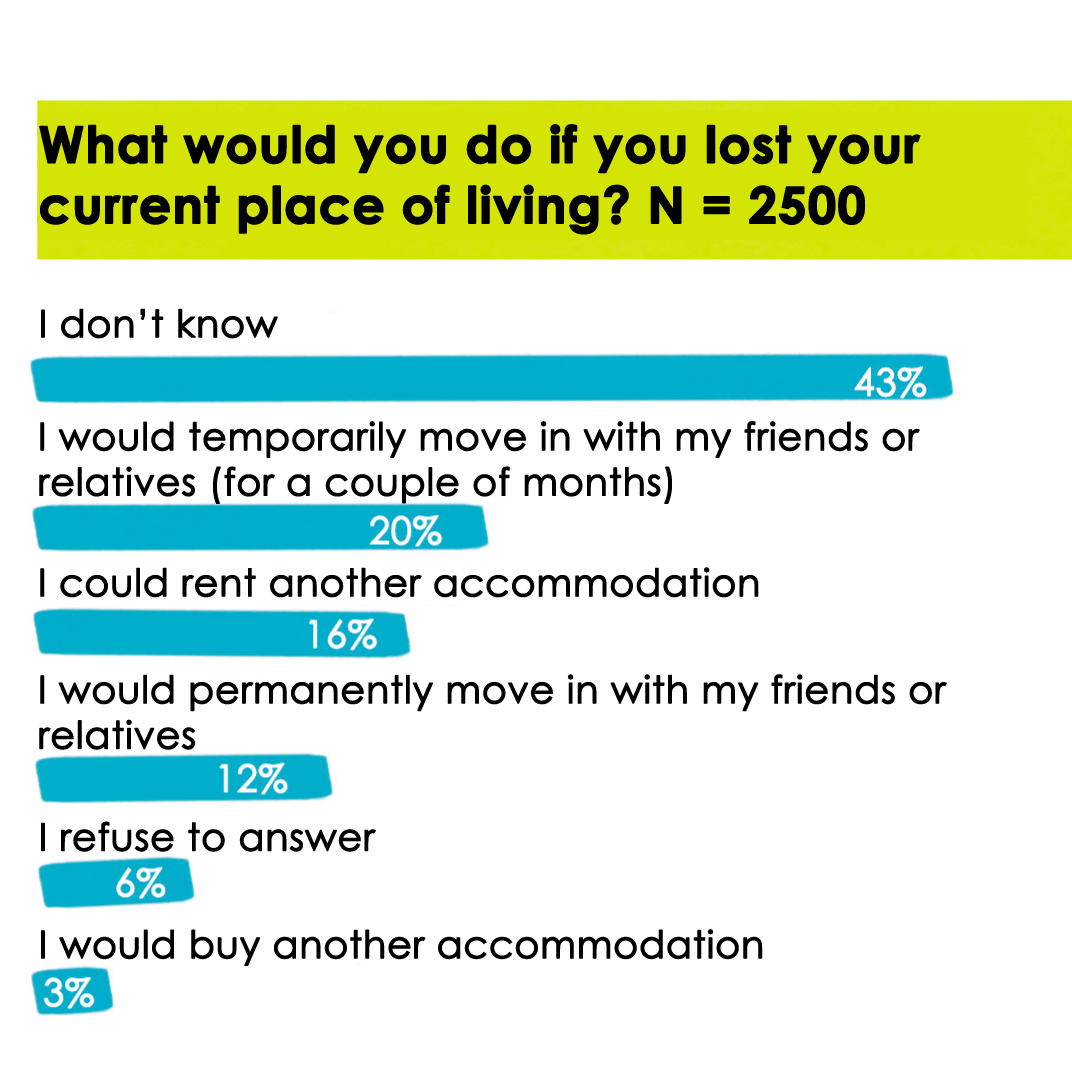
In general, the survey has shown that there are great expectations in the society regarding the government’s participation in housing provision. For instance, support for the government’s responsibility in all the statements which evaluated it does not fall below two thirds; in some aspects, the overwhelming majority of the respondents consider the state responsible. For example, 83% of the respondents rather or completely agree with the statement that the government must help citizens with purchasing housing. It is important to note that support for private housing ownership is strong. For instance, the overwhelming majority (85%) of the respondents are convinced that one can only say that a house is theirs when they own it; 67% believe that the government is the one who should provide people with housing to own (and 70% believe that this right applies to everyone).
According to a half of the respondents, the key category which should be targeted by state housing provision programs is orphaned children; according to 54%, young people with children must be in this category. Another third of the respondents (28%) believe that these programs should primarily target young people in general. Among the socially vulnerable population groups, the most highly supported are people with disabilities and low-income people: 41% and 28% of the respondents, respectively, support prioritizing these categories in state housing programs. Paradoxically, only 9% of the respondents consider homeless people — people who have no place to live — a category which state housing programs should target.
Half of those who wanted or needed to change the living conditions couldn’t answer how long would it take them to do so. Although 90% of them still expected to buy a house, they didn’t have enough funds to do so.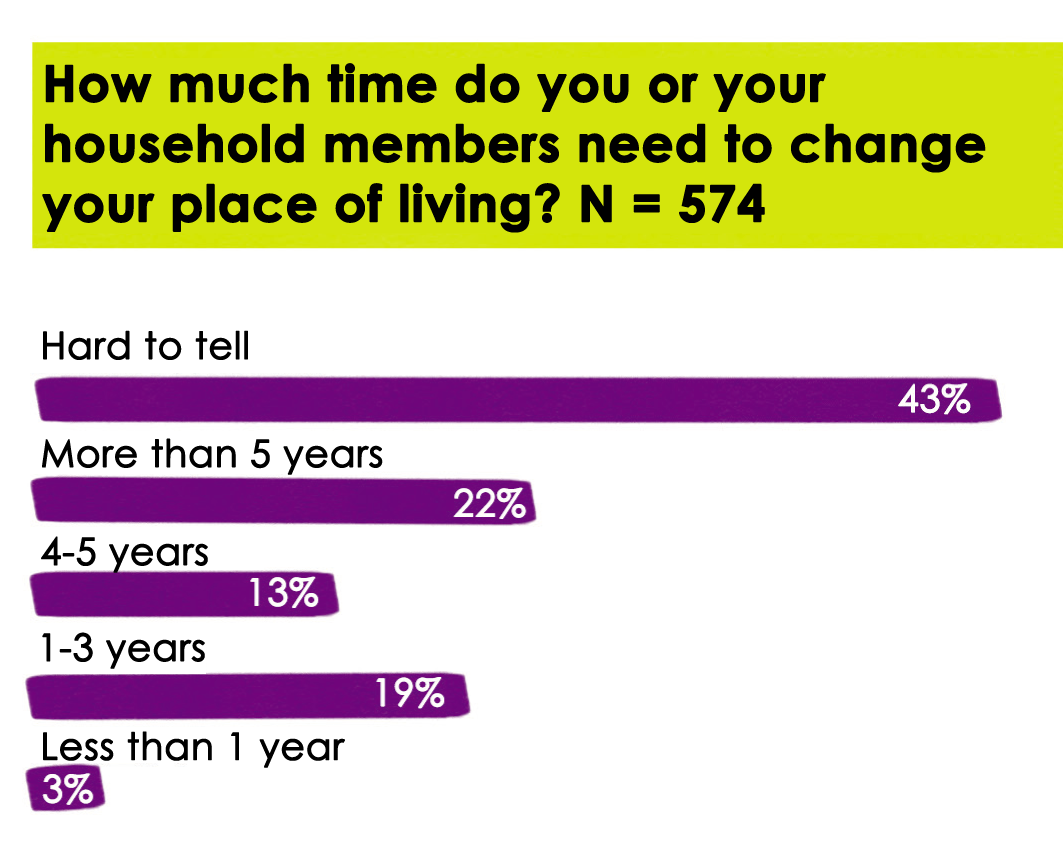
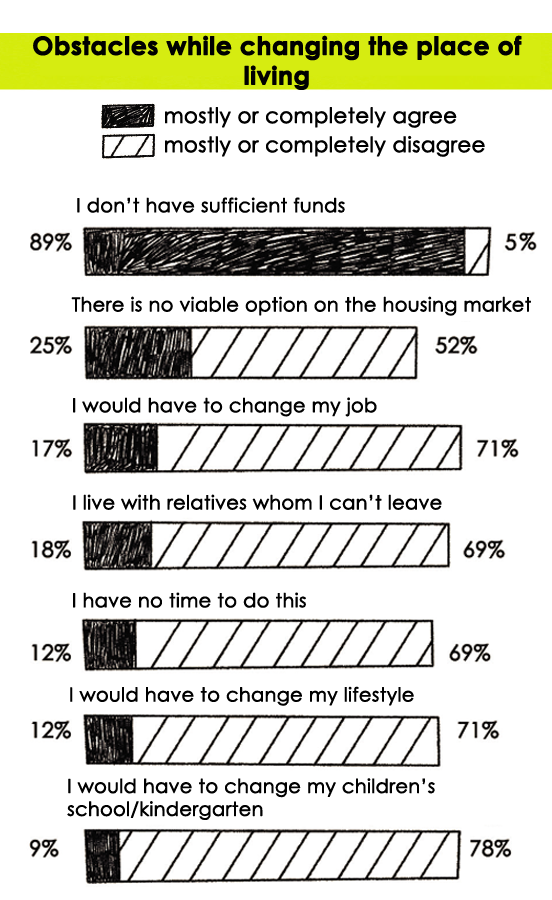
Renting is unregulated, unstable, and stigmatized. Only half of the respondents who rented accommodation said that they could live to the fullest and feel safe under these conditions. One-fifth of the respondents renting accommodation had been discriminated at least once while looking for a place of living. Another one fifth fear eviction without warning. Besides, house rental is expensive: half of the respondents have to cut other expenses because they spend from one third up to half of their total monthly income on rent.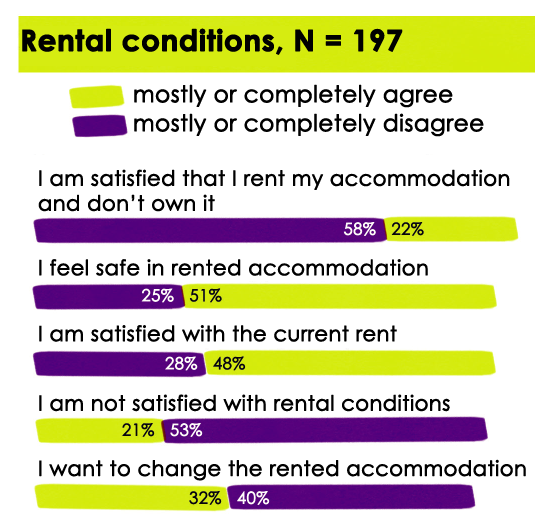
The difference between the regions is getting sharper. During the first years of independence, the living space for 1000 people was about 200-300 m² in every region. Now, Kyiv and Kyiv oblast are way ahead in terms of construction compared to other regions. What is the matter? What consequences does it have for the population? Today, the state pays insufficient attention to these issues.
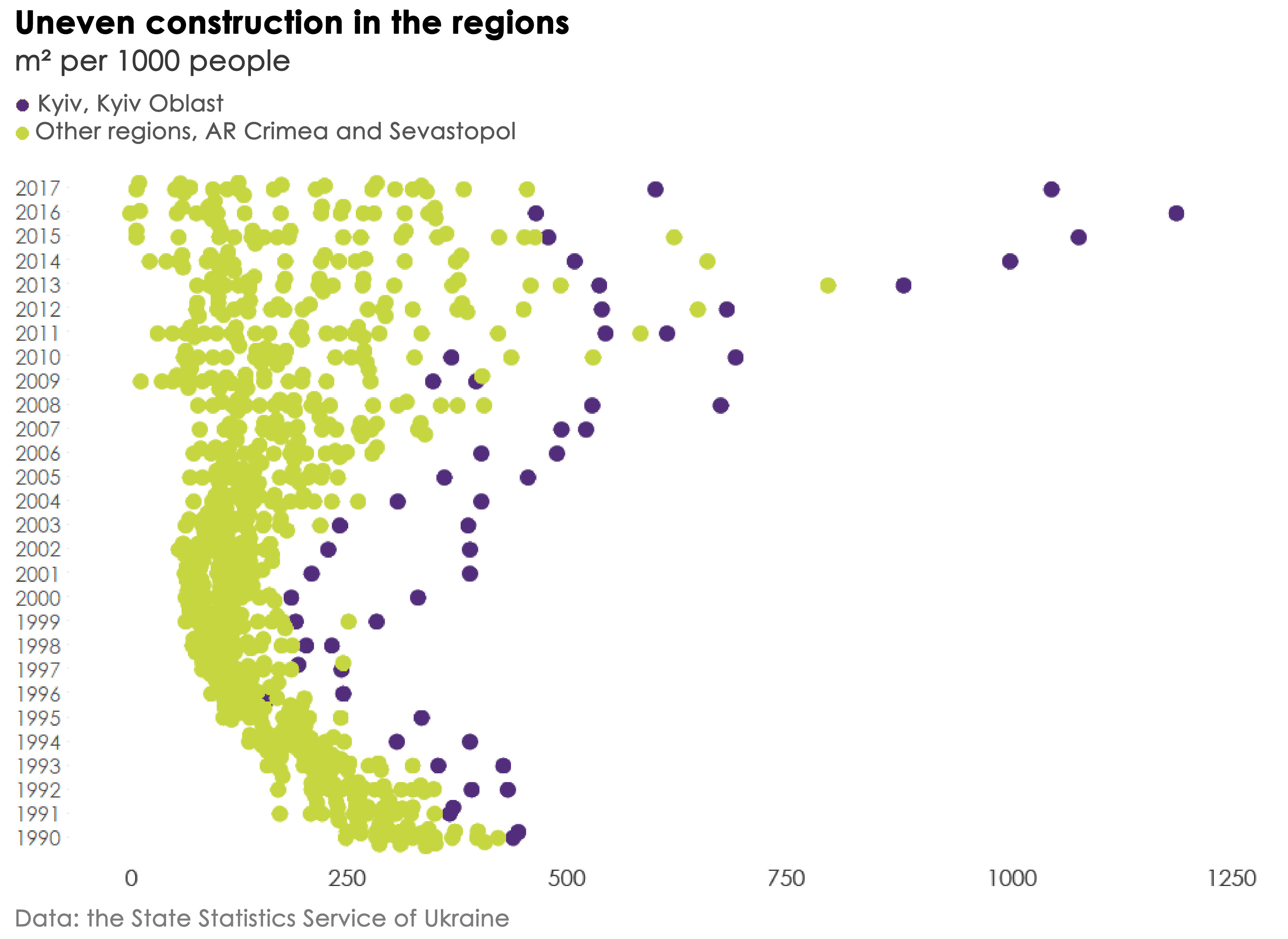
Towards the right to the housing: the potential for future projects and reform
Our survey findings have shown that society expects the state to pursue an active housing policy, but the state should also organize active information campaigns to explain how exactly the access to housing will be provided.
For a start, there has to be organized a broad discussion about what is housing, whose needs does state housing policy meet, and how exactly will it guarantee the constitutional right to housing. This is needed in order to develop a coherent public housing policy to replace specific sector housing programs. At the moment, the focus on small traditionally unchanged groups such as youth, particular professions, etc. hampers a coherent social policy.
The current state housing policy is neither just or efficient and therefore has to be reformed in order to become more balanced and neutral to all tenures. The first step should be the abolition of incentives towards homeownership. Currently existing public housing programs have to be integrated into a coherent public housing policy that focuses on use value of housing rather than expands homeownership. Subsidizing homeownership for certain categories of the population doesn’t meet the goals of economic efficiency and social justice.
The future projects and activities should focus on providing safe and affordable alternatives to homeownership by expanding the social housing stock and the regulation of the private rental market.
Recommendations
1. To begin a broad discussion about what is housing, whose needs does state housing policy meet, and how exactly will it enforce the constitutional right to housing.
2. To develop a coherent public housing policy to replace specific sector housing programs. At the moment, the focus on small traditionally unchanged groups such as youth, particular professions, etc. hampers a coherent social policy.
3. Based on the analysis of international experience, we recommend implementing a balanced housing policy that is neutral to all types of real estate ownership. The first step should be to stop encouraging real state ownership.
4. To incorporate current public housing programs into an integrated public housing policy that focuses on the use of real estate rather than expanding its ownership. Subsidizing real estate ownership for certain categories of the population doesn’t meet the goals of economic efficiency and social justice.
5. To encourage the use of the real estate as a place of living rather than a way of savings or assets protection, we recommend adopting changes to the Tax Code (Article 266) and abolishing tax credits on real estate tax (except for land taxes) for each subsequent unit of real estate. In terms of the tax base, we recommend differentiating the rate and calculating it according to accommodation costs, not its size.
6. To expand and support the rental sector, we should create homeownership alternatives. International experience and the results of our survey show that housing rental could effectively provide places of living to a large number of households.
7. Successful international experience shows that tenancy agreements must provide rental period guarantees (at least 3-5 years), restrictions on rent increases (inflation-related indexation or wage growth rates), and grounds for eviction.
8. To handle the registration of people living in rented accommodation.
9. To use shared tenancy agreements to maximize the use of privately owned surplus housing stock. Social leasing agencies will negotiate with individual property owners for long-term and lower rentals in return for stable rental income. Such accommodation could be rented out to persons who face discrimination in the rental market for individual property owners.
10. To complement the privately owned rental housing sector by creating a public rental sector. To do so, we must adopt the law that would enshrine the non-profit status of organizations engaged in construction, provision, and maintenance of the real estate.
International experience shows that integrated rental housing markets, that lack administrative barriers between the profit-making and non-profit sectors, successfully provide access to housing for different categories of the population. With the growing share of the public rental sector in the housing stock, it will be able to compete with the profit-making sector and have an indirect impact on it through quality, timing, and rent.
11. To keep a record of the population in need of better living conditions (the so-called “apartment queue”). To make a list of those who need social housing and monitor their needs and financial situation.
12. To explain to people why we should create the conditions for exercising the right to housing and what resources do we have to do so. Our survey has shown that the population has high expectations for housing but still doesn’t believe the state could live up to them.
Recommendations regarding housing data
1. To assess available resources and housing needs of the Ministry of Economy, the Ministry of Justice, the Ministry of Social Affairs, the National Bank, the State Tax Service, the State Statistics Service, and local self-government bodies must ensure the collection, analysis, and submission of statistical and administrative data related to housing. Datasets must include aggregate housing audit results, not disaggregated statistics, in which housing and population coexist.
2. Competent authorities must collect and analyze socio-demographic data on certain households and the purpose and characteristics of their property. These certain households are those that allocate funds to purchase real estate.
3. To conduct an integrated study of the connection between current living conditions and socio-economic characteristics of the population. Thus, government programs could work more effectively for people who need to improve their living conditions but have no resources to do so without government assistance.
4. The updates also require ways to calculate the indicators that assess the living conditions of the population. Moreover, when calculating the crowding index, it is essential to review the minimum rate and go from the minimum number of rooms to the minimum amount of space required for decent living conditions.
The study was conducted by the think tank CEDOS within the framework of the “Think Tank Development Initiative” conducted by the International Renaissance Foundation in partnership with the Open Society Initiative for Europe (OSIFE) and with the financial support of the Swedish Embassy in Ukraine.
The views expressed in the study belong to the authors and not necessarily coincide with those of the think tank CEDOS, the International Renaissance Foundation, the Open Society Initiative for Europe (OSIFE), and the Embassy of Sweden in Ukraine.
Any use of the materials from this publication is allowed provided the mention of the primary source is made no further than the second paragraph of the text.
Support Cedos
During the war in Ukraine, we collect and analyse data on its impact on Ukrainian society, especially housing, education, social protection, and migration













